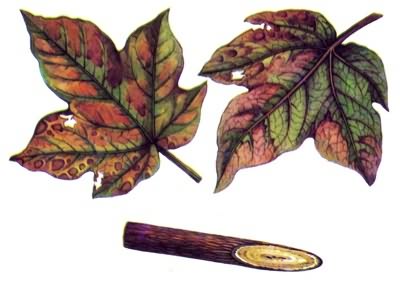Diseases
Verticillium dahliae var. dahliae Kleb. - Verticillium Wilt of Cotton.
Systematic position.
Kingdom Fungi, phylum Ascomycota, class Ascomycetes, order Hypocreales, genus Verticillium.Synonyms:
Verticillium dahliae Kleb., Verticillium albo-atrum var. dahliae (Kleb.) R. Nelson, Verticillium dahliae f. dahliae (Kleb.).Biological group.
Saprotroph.Morphology and biology.
The causative agent of tracheomycotic withering of cotton is the fungus V. dahliae having only anamorphous stage in its life cycle. Morphological structures of the pathogen are microsclerotia to 0.1 mm in size and septate colorless mycelium with verticillate conidiophores forming colorless monocellular conidia in heads of their sterigmas. The microsclerotia of the pathogen can remain in soil for several years. Affected cotton produces white sporulation of the fungus V.dahliae in damp conditions. The causative agent is a polyphage. It affects many field cultures, grasses, and tree species in addition to cotton. Sources of infection by V. dahliae are microsclerotia in soil and vegetation residues, infected seeds, aerogenic inoculum of conidia. Infection of cotton plants by the pathogen occurs basically in soil through roots after germination of microsclerotia in their rhizosphere. Penetrating into the vascular system of cotton through roots, the fungus causes tracheomycotic withering (wilt). The first single symptoms of cotton wilt appear in stage of 3-4 true leaves as mosaic necrosis between their veins. Intensive appearance occurs in the stage of early flowering. Affected leaf tissue loses turgor initially, then the leaves become pale green or yellow, later drying out completely. Reaching cotton bolls, the disease penetrates into seeds. Affected tissue of conductive vessels of leaves, petioles, stalks, and bolls becomes dark brown, which is a characteristic symptom of the disease. The disease epiphytoties leads to mass fall of leaves; some of them remain on plants but become dark brown. As a result, cotton plants appear to have been burnt by fire. Populations of the fungus V. dahliae are heterogeneous by virulence. A number of physiological races are revealed in the pathogen, which has a decisive importance in selection of cotton for resistance to the disease causative agent.Distribution.
The Verticillium Wilt is spread on cotton in countries of the former USSR everywhere. The disease shows the strongest severity in Uzbekistan, Kyrgyzstan, some areas of Tajikistan, Kazakhstan, and in Transcaucasian countries.Ecology.
The causative agent affects cotton more intensively at air temperature 23-25°C and soil humidity about 60%. The disease is most severe in irrigated agriculture, in places with high fraction of cotton in field crop rotations, and at late replacement of susceptible varieties by resistant ones.Economic significance.
Verticillium Wilt is the extremely harmful disease of cotton as it may affect more than 60% of plants. The disease causes the greatest harm to long-fibrous cotton (Gossypium hirsutum). Thin-fibrous cotton (Gossypium barbadense) is also affected by the Verticillium Wilt, but shows expressed tolerance to causative agent; therefore, having significantly smaller yield losses. Control measures are crop rotation with sufficient fraction of cereals and unaffected crops, application of biological preparation of Trichoderma, use of resistant varieties, and chemical control.Reference citations:
CABI Bioscience Databases. 2004. http://www.SpeciesFungorum.org .Gubanov G.Ya. 1972. Wilt of cotton. Moscow: Kolos, 385 p. (In Russian).
Kasyanenko A.G., Gorkovtseva E.A., Ryabova I.M. 1978. Physiological races of the causative agent of Verticillium wilt of cotton and their biotypes. Genetic variability of the causative agent of wilt and ways of increasing resistance of cotton. Dushanbe: Donish, p. 32-46. (In Russian).
Popov V.I. 1975. Scientific principles of IPM on cotton against soil borne infection. Abstract of PhD Thesis. Leningrad: VIZR, 45 p. (In Russian).
Popov V.I., Tarunina T.A., Usmanov Z.U. 1972. About physiological races of Verticillium dahliae Kleb., the causative agent of cotton wilt. Mycology and Phytopathology. Leningrad: Nauka, 6 (6): 500-502. (In Russian).
Solov.eva A.I., Poyarkova L.V. 1940. Wilt of cotton. Tashkent: Gosselkhozizdat, 62 p. (In Russian).
Yakutkin V.I. 1972. Comparative pathogenicity of two forms of V. dahliae on cotton varieties different by resistance to wilt. Mycology and Phytopathology. Leningrad: Nauka, 6(3): 291-292. (In Russian).
Yakutkin V.I. 1973. Pathogenicity of Verticillium dahliae Kleb. to varietes and forms of cotton. Abstract of PhD Thesis. Leningrad: VIZR, 24 p. (In Russian).
Voitenok F.V. 1970. Method of long-term forecast of Cotton Verticillium Wilt. Moscow: Kolos, 15 p. (In Russian).


